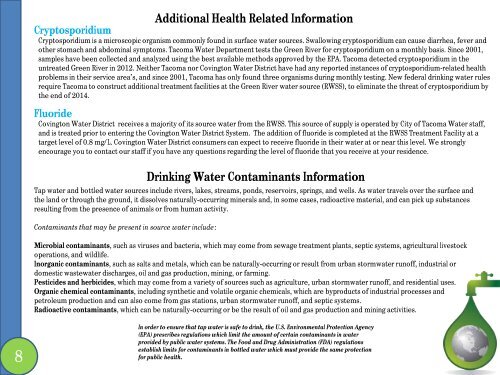2010 Annual Water Quality Report - CWD - Covington Water District
2010 Annual Water Quality Report - CWD - Covington Water District
2010 Annual Water Quality Report - CWD - Covington Water District
- No tags were found...
Create successful ePaper yourself
Turn your PDF publications into a flip-book with our unique Google optimized e-Paper software.
Additional Health Related InformationCryptosporidiumCryptosporidium is a microscopic organism commonly found in surface water sources. Swallowing cryptosporidium can cause diarrhea, fever andother stomach and abdominal symptoms. Tacoma <strong>Water</strong> Department tests the Green River for cryptosporidium on a monthly basis. Since 2001,samples have been collected and analyzed using the best available methods approved by the EPA. Tacoma detected cryptosporidium in theuntreated Green River in 2012. Neither Tacoma nor <strong>Covington</strong> <strong>Water</strong> <strong>District</strong> have had any reported instances of cryptosporidium-related healthproblems in their service area’s, and since 2001, Tacoma has only found three organisms during monthly testing. New federal drinking water rulesrequire Tacoma to construct additional treatment facilities at the Green River water source (RWSS), to eliminate the threat of cryptosporidium bythe end of 2014.Fluoride<strong>Covington</strong> <strong>Water</strong> <strong>District</strong> receives a majority of its source water from the RWSS. This source of supply is operated by City of Tacoma <strong>Water</strong> staff,and is treated prior to entering the <strong>Covington</strong> <strong>Water</strong> <strong>District</strong> System. The addition of fluoride is completed at the RWSS Treatment Facility at atarget level of 0.8 mg/L. <strong>Covington</strong> <strong>Water</strong> <strong>District</strong> consumers can expect to receive fluoride in their water at or near this level. We stronglyencourage you to contact our staff if you have any questions regarding the level of fluoride that you receive at your residence.Drinking <strong>Water</strong> Contaminants InformationTap water and bottled water sources include rivers, lakes, streams, ponds, reservoirs, springs, and wells. As water travels over the surface andthe land or through the ground, it dissolves naturally-occurring minerals and, in some cases, radioactive material, and can pick up substancesresulting from the presence of animals or from human activity.Contaminants that may be present in source water include:Microbial contaminants, such as viruses and bacteria, which may come from sewage treatment plants, septic systems, agricultural livestockoperations, and wildlife.Inorganic contaminants, such as salts and metals, which can be naturally-occurring or result from urban stormwater runoff, industrial ordomestic wastewater discharges, oil and gas production, mining, or farming.Pesticides and herbicides, which may come from a variety of sources such as agriculture, urban stormwater runoff, and residential uses.Organic chemical contaminants, including synthetic and volatile organic chemicals, which are byproducts of industrial processes andpetroleum production and can also come from gas stations, urban stormwater runoff, and septic systems.Radioactive contaminants, which can be naturally-occurring or be the result of oil and gas production and mining activities.8In order to ensure that tap water is safe to drink, the U.S. Environmental Protection Agency(EPA) prescribes regulations which limit the amount of certain contaminants in waterprovided by public water systems. The Food and Drug Administration (FDA) regulationsestablish limits for contaminants in bottled water which must provide the same protectionfor public health.


